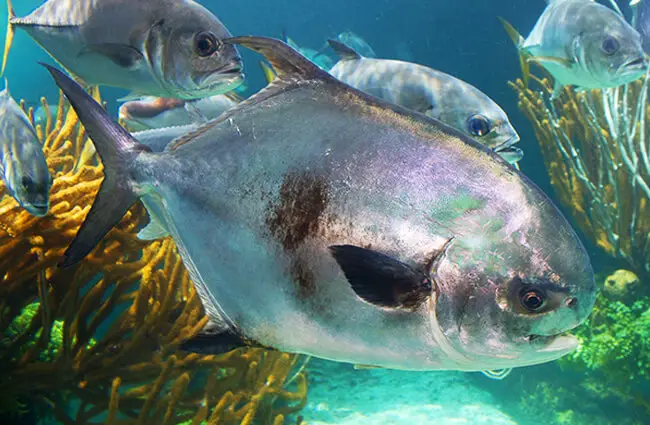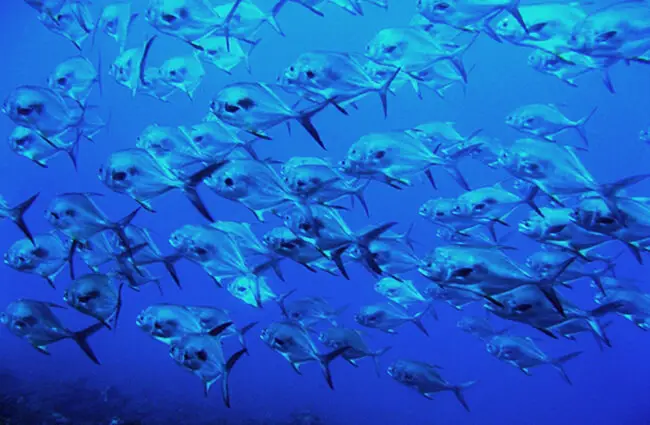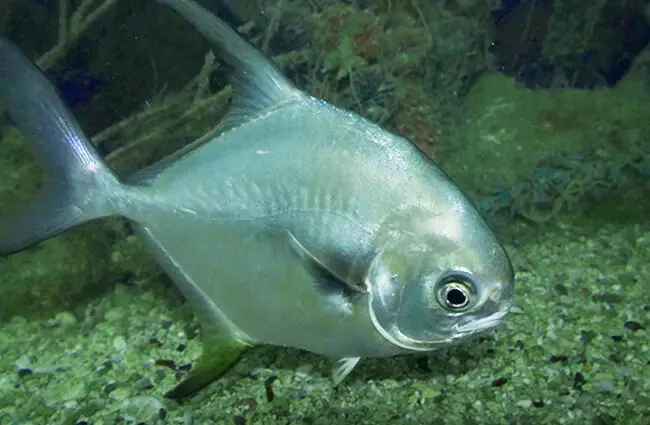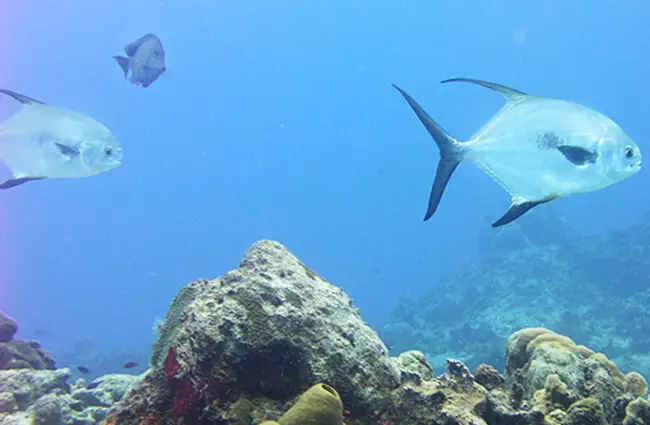The Permit: A Silver Phantom of the Flats
In the sun-drenched shallows of the tropical Atlantic, a creature of remarkable speed and cunning glides with an almost ethereal grace. This is the Permit, Trachinotus falcatus, a fish that has captivated the hearts of anglers, scientists, and nature enthusiasts alike. Known for its shimmering silver flanks, powerful tail, and elusive nature, the Permit is more than just a beautiful fish; it is a vital component of its marine ecosystem and a testament to the intricate dance of life beneath the waves.
Often mistaken for its close relative, the Pompano, the Permit stands out with its distinctive deep body, elongated dorsal and anal fins, and a reputation for being one of the most challenging and rewarding game fish to pursue. From its preferred habitats in clear, shallow waters to its specialized diet and complex social behaviors, the Permit offers a fascinating glimpse into the world of marine life.

What is a Permit?
The Permit, scientifically classified as Trachinotus falcatus, belongs to the Carangidae family, a group that includes jacks, trevally, and pompanos. This family is renowned for its fast-swimming, predatory marine fishes. Permits are characterized by their laterally compressed, disc-shaped bodies, which are typically silver with a faint yellowish tint on their undersides. Their most striking features are the long, sickle-shaped dorsal and anal fins, which can be tipped with black or orange, especially in larger specimens. An average adult Permit can reach lengths of up to 36 inches (91 cm) and weigh over 50 pounds (23 kg), though most encountered are smaller.
Where Do Permits Live? Unveiling Their Habitat
Permits are primarily found in the western Atlantic Ocean, ranging from Massachusetts in the United States, south along the coast of Florida, throughout the Caribbean Sea, and down to Brazil. They are also present in the Gulf of Mexico. These fish are masters of the shallow water environment, preferring clear, warm, tropical, and subtropical waters.
- Coastal Flats: Their most iconic habitat is the expansive, shallow sand and grass flats found in lagoons, estuaries, and along coastlines. These areas, often just a few feet deep, provide abundant food and protection.
- Surf Zones: Permits can also be found in the turbulent surf zones along beaches, where they forage for prey stirred up by the waves.
- Reefs and Wrecks: While less common, larger Permits may occasionally venture to deeper coral reefs or artificial wrecks, particularly during spawning aggregations.
- Mangrove Edges: The intricate root systems of mangroves offer shelter and a rich feeding ground for juvenile Permits.
Their preference for clear water is not just for aesthetics; it allows them to spot prey and predators effectively, relying heavily on their keen eyesight.

What Do Permits Eat? A Specialized Diet
The Permit is an opportunistic carnivore with a highly specialized diet, perfectly adapted to its shallow-water habitat. Their primary food sources include:
- Crabs: Small crabs, particularly those found on the flats, are a staple. Permits use their strong, crushing jaws to break open the shells of these crustaceans.
- Shrimp: Various species of shrimp are also a significant part of their diet.
- Mollusks: Clams, snails, and other small mollusks are dug out of the sand or grass.
- Small Fish: While not their primary prey, Permits will occasionally consume small baitfish if the opportunity arises.
They are often observed “tailing” on the flats, a behavior where they dip their heads down to root for food in the substrate, leaving their tails exposed above the water’s surface. This behavior is a tell-tale sign for observers and anglers alike.
Diving Deeper: The Intricacies of Permit Life
Physical Characteristics and Adaptations
The Permit’s physical form is a marvel of hydrodynamic efficiency. Its deep, compressed body allows for quick turns and bursts of speed, essential for navigating shallow environments and evading predators. The long, scythe-like dorsal and anal fins act like rudders, providing stability and precise control. The caudal fin (tail) is deeply forked and powerful, propelling the fish with incredible force. Their silvery coloration provides excellent camouflage in the reflective waters of the flats, making them incredibly difficult to spot against the shimmering bottom or sky. Some individuals exhibit a yellowish or orange patch on their belly or fins, which can vary in intensity.

Life Cycle and Reproduction
The reproductive cycle of the Permit is a fascinating journey from open ocean to shallow nursery grounds. Spawning typically occurs offshore in deeper waters, often around reefs or wrecks, during the warmer months of spring and summer. Permits form large aggregations for this purpose, releasing eggs and sperm into the water column, a process known as broadcast spawning.
- Larval Stage: The fertilized eggs are pelagic, drifting with ocean currents. The larvae are tiny and undergo several developmental stages in the open ocean.
- Juvenile Migration: As they grow, juvenile Permits migrate towards shallower coastal waters, including mangrove estuaries and seagrass beds, which serve as crucial nursery habitats. These areas provide abundant food and protection from larger predators.
- Growth and Maturity: Permits grow relatively quickly, reaching sexual maturity within a few years. They can live for over 20 years in the wild, with larger, older individuals often being the most challenging to encounter.
Social Behavior and Ecosystem Contribution
Permits exhibit varying social behaviors depending on their age and activity. Juveniles often form schools for protection, moving together across the flats. Adult Permits can be found singly, in pairs, or in small groups, particularly when foraging. During spawning, they form much larger aggregations.
Their role in the ecosystem is significant:
- Predator: As a predator of crabs, shrimp, and mollusks, Permits help regulate the populations of these invertebrates, contributing to the health of seagrass beds and sandy bottoms.
- Prey: Younger Permits are prey for larger predatory fish, sharks, and marine birds. Adult Permits, while formidable, can fall victim to large sharks and other apex predators, thus contributing to the marine food web.
- Nutrient Cycling: By consuming and processing prey, Permits contribute to the cycling of nutrients within their habitats.

The Evolutionary Journey of the Permit
The Permit’s lineage traces back millions of years within the Carangidae family, a diverse group of marine ray-finned fish. Evolutionary pressures have sculpted the Permit into the highly specialized creature it is today. Its deep, compressed body plan is a common adaptation among fish that inhabit shallow, complex environments, allowing for agility and quick bursts of speed to escape predators or ambush prey. The development of strong, crushing pharyngeal teeth (located in the throat) is a key adaptation for its mollusk and crustacean-heavy diet. Over millennia, natural selection has favored individuals with superior camouflage, keen eyesight, and efficient foraging strategies, leading to the highly refined species we observe today. Their ability to thrive in both open water and extremely shallow flats demonstrates a remarkable evolutionary flexibility.
Permits and Humans: Interaction and Culture
The Permit’s interaction with humans is primarily centered around recreational fishing and, to a lesser extent, observation. They are highly prized as a game fish, particularly by fly anglers, due to their intelligence, wariness, and powerful fighting ability. Catching a Permit on a fly rod is often considered the pinnacle of saltwater fly fishing.
- Recreational Fishing: The pursuit of Permit supports a significant ecotourism industry in regions like Florida, Belize, and the Bahamas. Most Permit fishing is done on a catch-and-release basis, emphasizing conservation.
- Conservation: While not currently listed as endangered, Permits face threats from habitat degradation (especially seagrass beds and mangroves), water quality issues, and localized overfishing. Responsible fishing practices and habitat protection are crucial for their continued survival.
- Cultural Contribution: The Permit’s contribution to human culture is largely tied to its status as an iconic sport fish. It symbolizes the challenge and beauty of the marine environment, inspiring countless stories, artworks, and conservation efforts within the angling community. Its elusive nature has fostered a deep respect among those who pursue it.

A Huge List of Interesting Facts About Permits
- Permits can change their coloration slightly to blend in with their surroundings, appearing darker over seagrass and lighter over sand.
- They possess excellent eyesight, which is crucial for spotting their camouflaged prey and avoiding predators in clear water.
- The world record Permit caught on rod and reel weighed over 56 pounds (25.4 kg).
- Despite their size, Permits are incredibly agile and can navigate extremely shallow water with ease.
- Their scientific name, Trachinotus falcatus, means “rough back” (Trachinotus) and “sickle-shaped” (falcatus), referring to their dorsal fin.
- Permits are known for their powerful runs and stamina, making them a formidable opponent for anglers.
- They are often seen “mudding” or “tailing” as they root for food in the bottom substrate.
- Juvenile Permits sometimes have vertical bars on their sides, which fade as they mature.
Practical Insights: Finding, Observing, and Caring for Permits
Finding Permit in the Wild: A Guide for Animal Lovers
For those eager to observe Permits in their natural habitat, patience and a keen eye are paramount. These fish are notoriously wary.
- Location: Focus on shallow, clear water flats in Florida (especially the Keys), the Bahamas, Belize, and other Caribbean nations. Look for areas with a mix of sand, seagrass, and coral patches.
- Timing: Early morning or late afternoon often provides the best light for spotting them, as the sun’s angle reduces glare. Calm, clear days are ideal.
- Observation Techniques:
- Polarized Sunglasses: Absolutely essential for cutting glare and seeing into the water.
- Look for Movement: Watch for subtle movements, shadows, or flashes of silver.
- Tailing: The most obvious sign is a Permit “tailing” as it feeds, with its tail fin breaking the surface.
- Wakes: On very calm water, a Permit’s movement can create a subtle wake.
- Boats/Kayaks: Using a shallow-draft boat, kayak, or paddleboard allows for quiet access to flats. Poling a skiff is a common method to avoid spooking them.
- Snorkeling/Diving: In some areas, snorkeling or free-diving can offer incredible close-up views, but approach slowly and quietly to avoid disturbing them.
- Respectful Observation: Maintain a respectful distance. Sudden movements or loud noises will send them fleeing.

Encountering Permit in the Wild: What to Do (for Observers)
If you are snorkeling, diving, or simply observing from a boat and encounter a Permit:
- Stay Calm and Still: Sudden movements will startle them.
- Observe from a Distance: Do not attempt to chase or touch the fish. Allow it to continue its natural behavior.
- Minimize Disturbance: Avoid making loud noises or splashing. If you are in a boat, turn off the engine and pole or drift.
- Appreciate the Moment: These are wild animals in their natural environment. Enjoy the privilege of witnessing them.
Caring for a Permit in Captivity: A Zookeeper’s Guide
Keeping Permits in captivity, especially large adults, is a specialized task typically undertaken by public aquariums due to their size, specific environmental needs, and diet. Here are key considerations:
- Habitat Requirements:
- Tank Size: Requires very large, spacious tanks, ideally thousands of gallons, to accommodate their swimming needs and potential adult size. A long, wide tank is preferable to a deep one.
- Water Quality: Pristine marine water quality is non-negotiable. This includes stable salinity (around 1.023-1.025 specific gravity), temperature (75-82°F / 24-28°C), pH (8.1-8.4), and undetectable ammonia/nitrite, with low nitrates. Robust filtration (mechanical, biological, chemical) is essential.
- Substrate and Decor: A sandy bottom is beneficial, allowing them to exhibit natural foraging behaviors. Minimal, smooth rockwork or artificial coral can be included, but open swimming space is paramount. Avoid sharp objects.
- Water Flow: Moderate to strong water flow is important to simulate their natural environment and aid in oxygenation.
- Diet and Feeding:
- Primary Diet: A varied diet of high-quality frozen or fresh crustaceans (shrimp, crabs), mollusks (clams, squid), and small fish. Supplement with vitamin-enriched foods.
- Feeding Frequency: Juveniles may require multiple feedings per day; adults typically once daily or every other day. Monitor body condition.
- Foraging Enrichment: Hiding food in the sand or using feeding devices can encourage natural foraging behaviors.
- Social Behavior and Tank Mates:
- Schooling: Juveniles do well in schools. Adults can be kept singly, in pairs, or in small groups, but monitor for aggression, especially during feeding.
- Tank Mates: Choose tank mates carefully. They should be similarly sized, non-aggressive, and able to tolerate similar water parameters. Avoid very small fish that could be seen as prey or overly aggressive species. Other large jacks or snappers might be suitable in very large exhibits.
- Health and Monitoring:
- Disease Prevention: Maintain excellent water quality and quarantine new arrivals to prevent disease introduction.
- Common Issues: Stress from poor water quality, inadequate space, or improper diet can lead to fin rot, parasitic infections, or bacterial issues.
- Observation: Regular observation for changes in behavior, appetite, coloration, or physical signs of illness is crucial.
- What to Avoid:
- Small Tanks: Absolutely avoid housing Permits in tanks that are too small for their potential adult size.
- Poor Water Quality: Neglecting water parameters will lead to stress and disease.
- Monotonous Diet: A lack of dietary variety can lead to nutritional deficiencies.
- Aggressive Tank Mates: Do not house with overly aggressive or territorial species that could injure them.
- Sudden Changes: Avoid rapid changes in water parameters or environment, which can cause stress.
The Enduring Allure of the Permit
From the shimmering flats where it hunts to the deep blue waters where it spawns, the Permit is a creature of enduring fascination. Its blend of beauty, power, and elusive intelligence makes it a true gem of the marine world. Understanding this remarkable fish not only enriches our appreciation for individual species but also highlights the interconnectedness of all life in our oceans. As we continue to explore and learn, the Permit stands as a vibrant symbol of the wild, urging us to protect the precious habitats it calls home for generations to come.

![Red Angus Closeup of a beautiful Red Angus cowPhoto by: U.S. Department of Agriculture [pubic domain]https://creativecommons.org/licenses/by/2.0/](https://animals.net/wp-content/uploads/2020/03/Red-Angus-4-238x178.jpg)




![Red Angus Closeup of a beautiful Red Angus cowPhoto by: U.S. Department of Agriculture [pubic domain]https://creativecommons.org/licenses/by/2.0/](https://animals.net/wp-content/uploads/2020/03/Red-Angus-4-100x75.jpg)

